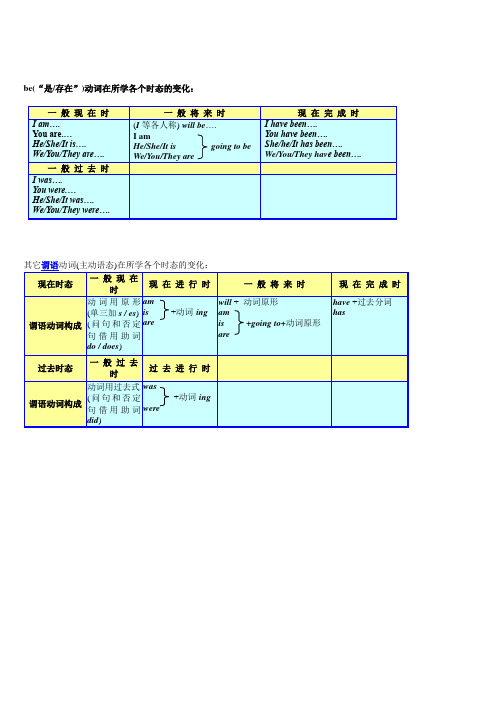初中动词的时态变化表
- 格式:doc
- 大小:352.00 KB
- 文档页数:4

动词的各种时态及变化规则一、一般现在时用法:1.现阶段经常性、习惯性动作;2.目前的状态;3.客观真理。
构成:主语是第三人称单数时,作谓语的行为动词要在词尾加-s(-es),其他人称和数用动词原形。
否定形式:am/is/are+ not;此时态的谓语动词若为行为动词,则在其前加don't,如主语为第三人称单数,则用doesn't,同时还原行为动词。
一般疑问句:把be动词放于句首;用助动词do提问,如主语为第三人称单数,则用does,同时,还原行为动词。
时间状语:always, usually, often, sometimes, every week (day, year,month…), once a week, on Sundays动词的变化规则(1)一般直接在词尾+s runs likes(2) 以s, sh, ch, x, o结尾的动词在词尾+es goes passes(3) 以辅音字母+y结尾的动词,要把y变i+esstudy ---studies try----tries(4) 以元音字母+y结尾的动词,直接在后+s stays plays二、现在进行时用法:a. 表示现在( 指说话人说话时) 正在发生的事情。
b. 表示长期的或重复性的动作,说话时动作未必正在进行。
构成:主语+am / is / are + 动词的现在分词(即动词-ing 形式)否定形式:主语+am / is / are + 动词的现在分词一般疑问句:把am / is / are放于句首。
时间状语:these days, now, at the moment, look, listen.现在分词的变化规则(1).一般直接在动词词尾+ing reading(2).以不发音e结尾的动词要把e去掉+ing live---living(3).以重读闭音节的结尾且末尾只有一个辅音字母的动词,双写辅音字母再ing run---running 注:重读闭音节:辅+元+辅并且元音是单元音(4).特殊记忆的动词die---dying 死lie---lying 躺tie---tying 栓系三、一般过去时用法:过去某个时间里发生的动作或状态;过去习惯性、经常性的动作、行为。




初中英语动词时态归纳总结对照表初中英语动词时态归纳总结对照表初中英语动词时态语态归纳总结对照表名称一般现在时一般过去时 1.be+V-ing形式①tomorrow2.begoingto(morning/afternoon…+V-原形一般将来 3.will+V-原形②next时..③4.主语(I/We)year/month/week.+shall+原形inthefuture,④in+一段时间,⑤soon等will+be+p.p1.V-过去式2.be的过去式是was/were.yeste rday(morning/afternoon………)lastnight/year…in+过去年份,一段时间+ago,justnow.was/were+p.p1.有was/were时可以直加直提。
2.没有时,借助于助动词did,切记使用did后谓语动词要恢复原形.1.主语+be (am、/is/are)+表语2.主语(单三)+V-单三谓语结构标志词被动语态谓语结构助动词及疑否句构成am/is/are+p.everyday/morning….pusually,oftensometimes,always,onSundays1.有am/is/are时可以直加直提。
2.没有时,主语为单三时借助于does,非单三时借助于do。
切记使用助动词does后,动词应恢复原形。
Will和be可以直加直提。
现在进行时过去进行时Look!listen!now等am/is/are+V-ingam/is/are+being+p.pbe动词可以直加直提was/were①atthis/thattime+过去时间②at+时刻数+being+p.p+过去时间③from+时刻Was/were+V-ing数+to+时刻数+过去时间④主句(过去进行时)+when+从句(一般过去时)was/were可以直加直提①already,yet,ever,sofar,justbefore,never,twice,threetimes,thesedays,inthepast/lastfewyears,recently等have/has+动词过去分词②for+一段时间和since+过去时间③.主句(现在完成时)+since+从句(一般过去时)④Itis/hasbeen+一段时间+since+从句(一般过去时)have/has+been+p.p1.have/has可以直加直提2.already用在肯定句的句中或句末,而yet用在疑否句的句末。

展宏学校中考英语常考八大时态与被动语态类别一般现在时现在进行时现在完成时一般将来时用途1.表示经常性、习惯性的动作;2.表示客观事实或永恒真理;3.表示特征、爱好、状态和能力等。
表示现在(说话瞬间) 正在进行或发生的动作。
1. 表示发生在过去的动作一直持续到现在; 2.表示发生在过去的动作对现在造成的影响或结果。
表示将来某个时间要发生的动作或存在的状态。
谓语结构(动词形式) V.原或V.三单(he/she/it或能够用he/she/it代替的人或物后用三单)am / is / are + V.-ing have/has + 过分 1.will + V.原2.be going to + V.原被动结构am / is / are + 过分am / is / are +being+过分have / has been + 过分will be + 过分时态标志1.频率副词:often; sometimes=(attimes); always; usually; every day(every + 时间)2. 次数:twice a week3.on Sundays:在每一个星期天例句:He often cleans the room. (主动)The room often by him.(被动)1. now = at present = rightnow = at the moment2. look, listen 开头的句子。
例句:She is watering the treesnow. (主动)The trees byher now. (被动)1. for / since+时间;2. 副词ever, never, yet,already等;3. so far = by now=up tonow;4. in the last/past fewyears;5. over the years= inrecent years1. 将来的时间:tomorrow;the dayafter tomorrow;next week ;in a fewdays;in 3 years;in the future ;thisevening/year/week2. at once=in a minute=right away3. soon例句:She will do it tomorrow. (主动)It by hertomorrow. (被动)易错小结在主从复合句中,当主句为一般将来时、主句为祈使句、主句含有情态动词时,从句必须用一般现在时。
初中英语六种时态一览表六种时态一览表时态用法一般现在时一般过去时现在进行时过去进行时一般将来时现在完成时表示经常性发生的动表示过去某个时间发表示现在或现阶段正表示过去某时正在进表示将来某个时间要表示过去发生或者未作、习惯性动作或客生的动作或存在的状在进行或发生的动行的动作或存在的状发生的动作或存在的发生的事对现在造成观真理、科学事实等。
态。
作。
态。
状态。
的影响或结果。
频度副词:always,often,usually,sometimes,seldom,never;everyday,everyweek,every month,every year等thedaybefore yesterday,yesterday, last/yesterdaynight, lastweek,lastmonth, lastyear,lastterm;in/on+曩昔工夫;工夫+ago; just now, at the age of 5, one day, long long ago; once upon a timenow, at the moment, at thismoment,just now,look, listen, at present, these days, this weekjustthen,atthis momentyesterday, yesterdaymorning/ afternoon/evening,at thattime,thismorning,thewholemorning,alldayyesterday,from+时间数+to+时间数+lastnight, those days或以when, while引导的谓语动词是普通曩昔时的时间状语等。
was/were+动词的目前分词tomorrow;thedayalready, yet, just, ever, aftertomorrow;nextnever, before, for +时day/week/month/year/间段,since+时间点term;soon;inafewminutes;by+年份;in+工夫状语;inthefuture; in future工夫标记构成体式格局1.动词be(am/is/are) +表语…2.动词真相+…(主语是第三人称单数,动词也用第三人称单数)1.动词was/were+表语2.实义动词的过去式+…be(am/is/are) +动词的目前分词原形过去分词+…(shall用于第一人称) 2. be going to +动词原形疑句问型式1. Be +主语+…?2. Do/Does +主语+动词真相+…?1. Was/Were +主语+…?2. Did +主语+动词原形+…?Be+主语+动Was/Were+主语 1. Will/Shall +主语Have/Has+主语+过词的目前分词+动词的目前分词+动词真相+…?去分词+…?+…?+…?2.Be+主语+goingto+动词真相+…?1.主语+will/shall主语+ haven’t / hasn’t ++动词的目前分wasn’t (was not)/not+动词真相曩昔分词+…词+…weren’t(werenot)++…动词的目前分词2.主语+ be + not ++…goingto+动词原形+…变否1.主语+be+not1.主语+ was/were主语+ be + not主语+ +…+ not +…化定2.主语+don’t/doesn’t2.主语+ didn’t +。
英语八大时态讲解动词的时态有很多。
初中阶段主要掌握八种:一般现在时、一般过去时、现在进行时、过去进行时、一般将来时、过去将来时、现在完成时、过去完成时。
(一一般现在时1一般现在时态的构成:主语是I, we, you, they和名词复数时作谓语的行为动词用原形。
主语是he, she , it和名词单数时,作谓语的行为动词的词尾变化如下:一般情况+s以s, x, ch, sh 或o结尾+es以辅音+y结尾去y变i+es2一般现在时态的肯定句、否定句和疑问句形式(以be和like为例:He/ She is a student.I / We/ You/ They/ like music.Many people like music. I am not a student.Is he/ she a student?Do you/ they like music?Do many people like music?3一般现在时态的用法:现阶段经常性,习惯性的动作。
例如:I get up at six every morning.He plays tennis once a week.举例:A 现在的状态My mother is a teacher. She teaches English in a school.B 客观真理The earth goes around the sun.4常用于一般现在时态的时间状语:often usually sometimes always every day never in the morning 等。
例题解析:举一反三,学的更轻松!1. --- May I help you, sir?--- Yes, I bought the TV the day before yesterday, but it ______.A. didn’t workB. doesn’t workC. won’t workD. can’t work解析:电视虽然是前天买的,但坏了是现在的状态,应该用一般现在时态。